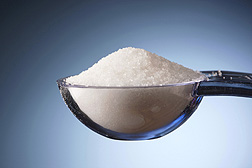This page has been archived and is being provided for reference purposes only. The page is no longer being updated, and therefore, links on the page may be invalid.
| Read the magazine story to find out more. |
|
|
|
|
Assessing the U.S. Population's Sodium Intake
By Rosalie Marion Bliss
December 2, 2013
U.S. Department of Agriculture (USDA) scientists used an automated dietary survey tool they developed to accurately estimate how much sodium volunteers consumed as part of their daily diets.
The scientists, with USDA's Agricultural Research Service (ARS), found that the volunteers' sodium intake estimates were 90 to 93 percent accurate among men and women. Sodium intake has become a hot topic as public policymakers address regulatory proposals aimed at lowering sodium in foods. In 2010, the Institute of Medicine issued a report recommending that new national sodium standards be implemented by the federal government.
ARS is USDA's chief intramural scientific research agency.
Researchers at the ARS Beltsville Human Nutrition Research Center in Beltsville, Md., developed the Automated Multiple Pass Method (AMPM), an innovative surveying tool used to obtain information on the amounts of foods and beverages consumed by a survey volunteer during a 24-hour period.
Several major food manufacturers have long been implementing sodium-reduction strategies through self-regulation. The usefulness of proposed regulatory steps will depend on accurate and practical methods to monitor the U.S. population's sodium intake.
The accuracy of sodium intake was calculated as the ratio of reported dietary intake to that estimated from urinary sodium excretion. The results showed that the dietary sodium intake estimates reported by volunteers derived using the ARS survey interview method were accurate when cross-checked against the urinary sodium excretion data.
Results from this study are significant because they demonstrate that the dietary survey method is a valid tool for estimating sodium intake as well as energy intake. The current ARS national food and nutrient intake survey uses the automated tool for both in-person and telephone interviews.
The automated tool will continue to accurately estimate the population's sodium intakes from foods as food composition databases produced by ARS are routinely updated to reflect changes in the salt content of foods consumed, according to the study's lead author Donna Rhodes, a nutritionist at the Beltsville center.
The study was published in the American Journal of Clinical Nutrition.

